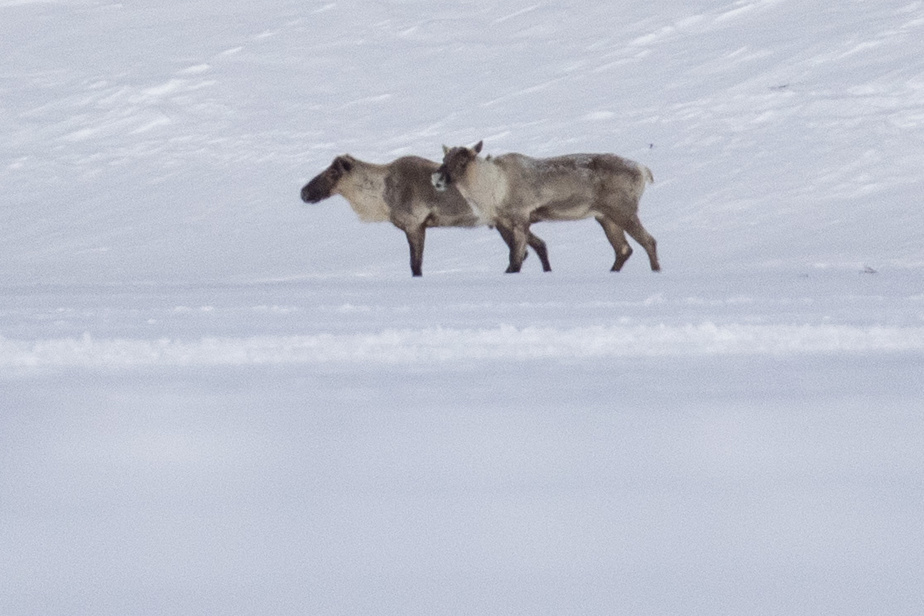(Montreal) Quebecers would be willing to pay an average of $55 per person annually to protect woodland caribou populations, over a period of 20 years.
This is reported by a study by the Canada Research Chair in Ecological Economics at the University of Quebec in Outaouais.
“Our study reiterates that the woodland caribou is a highly valued species and that the population is ready to support conservation actions,” said Jérôme Dupras, professor and holder of the Chair.
Scientists interviewed 863 people in this study.
The vast majority of respondents (90%) would like “the Government of Quebec to put a little or a lot more effort” into protecting the species, with almost half (48%) favoring a lot more effort.
Only 2% of respondents reported that they wanted less support and 8% of respondents indicated that they would not want any change.
The researchers presented the respondents with different caribou protection scenarios including the deterioration of its protection, the status quo and the improvement of its situation. These scenarios were also accompanied by a financial contribution.
The results of the exercise show that, on average, the Quebec population is ready to finance the recovery of caribou populations at the level of $55 per year over a period of 20 years.
Professor Dupras explained that “there was no choice, within the study, on the types of actions” that Quebecers would like to see to protect the caribou, but that “these actions, they are known, ecological restoration must be carried out”.
What should be remembered, he said, is the “signal” that the population sends to the government.
“We have an exact quantified reflection of what people want us to do with their money in terms of biodiversity, so they would like an average of $55 of their taxes that they pay each year to be dedicated to the protection and caribou restoration. »
This individual contribution would represent a value of 258 million annually, according to the study.
The study stems from an order made by the Ministry of Forests, Wildlife and Parks a few years ago.
“It was a study on the economic value of endangered species in the broad sense,” said Jérôme Dupras.
The survey also focused on the recovery of wood turtle, copper redhorse, beluga whale and rusty-patched bumblebee.
“The peer-reviewed study, it came out last fall and then we went back to that database and with our statistical processing, we were able to isolate the caribou data specifically,” because it This is a species that Quebecers are particularly fond of, explained researcher Jérôme Dupras.
Respondents were also asked to give their opinion, based on a choice of answers, on the reasons why certain vulnerable species attracted them more than others.
The reason most often chosen (60%) was “species at risk play an important ecological role”, followed by “species at risk are very vulnerable” at 47%, “species at risk are emblematic for the Quebec” at 38%, “Species with precarious status are rare” at 31% and “I read/listened to something about these species and it marked me” at 29%, underlines the survey.
Caribou populations in Quebec, heavily disturbed by human activity, continue to decline according to the latest inventories published at the beginning of the year by the Ministry of the Environment, the Fight against Climate Change, Wildlife and Parks. .
These inventories were carried out in 2021 and 2022 in the Gaspésie, Nord-du-Québec and Côte-Nord regions, and in all three regions the populations continue to decline, mainly due to the destruction of their habitat. Only the Caniapiscau caribou population would be growing.
A strategy will be presented in June
Environment Minister Benoit Charette is due to present his caribou protection strategy next June.
Tuesday, during a study of budget appropriations in Quebec, the minister explained that new protected areas will soon be announced.
“There will be protected areas, announced in the coming weeks, I won’t start naming, at the risk of forgetting some. Then, there is still work to be done on our side. But there will also be protective measures on the side of the Pipmuacan. That’s a must,” he said.
The Innu Council of Pessamit has long called for the Lake Pipmuacan sector to be protected, in particular to prevent the logging industry from decimating the caribou herd in this region located northeast of the city of Saguenay.
In August 2022, the council even sent a formal notice to Ottawa and Quebec to protect the caribou in this region.

